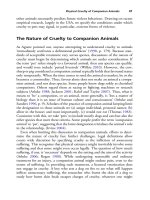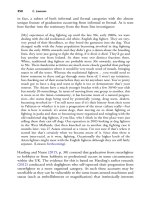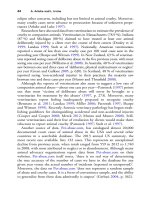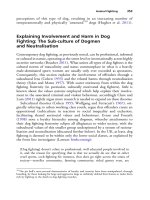The palgrave international handbook of a 168
Bạn đang xem bản rút gọn của tài liệu. Xem và tải ngay bản đầy đủ của tài liệu tại đây (36.63 KB, 1 trang )
160
E. Cudworth
in the West (cattle, sheep, pigs and chickens), there will be brief mention of
less common farmed animals (such as rabbits) and those which are not clearly
‘domesticated’ (fishes in ‘aquaculture’, for example).
This chapter will suggest that the normative everyday practices of animal
agriculture within which billions of animals are bred and raised are collectively part of the most widespread and systematic abuse of non-human
animals. There are two senses in which this might be understood. Standard
dictionary definitions of the term ‘abuse’ suggest that it is first, a misuse or
misemployment; and second, that it is a cruel or violent treatment of a
human or non-human animal with intent to harm. The breeding and rearing
of farmed animals is naturalised in Western (and other) cultures but is
unnecessary and involves the creation of artificial populations of creatures
who live short and harsh lives—it is a misuse of non-human creatures. The
processes of animal agriculture also involve systematic cruelties and violences
towards the creatures who are farmed. The breeding and rearing (and killing,
see Chapter on Slaughterhouses in this volume) of farmed animals is, in sum,
an institutionalised site of animal abuse. Comparing contemporary animal
agribusiness to other sites of institutionalised animal abuse, Erin Williams
and Margot de Mello rightly argue that it is the most extreme and normative
example of our exploitation of animals—globally, 99 % of all domesticated
animals are commodities in animal agriculture (Williams and de Mello 2007,
p. 14). This largest of animal populations, those used for ‘food’, are caught in
relations of human dominion that involve their exploitation and oppression.
There are some who argue that we have seen some positive changes, for
example in the UK or the European Union in terms of ‘improvements’ in
farmed animal welfare and the mainstreaming of ideas about ‘happy’ and
‘humane’ farming associated with ‘free-range’ or ‘ethically’ produced animalbased food (Bock and Buller 2013). However, in terms of the global spread
of intensive and industrial models of animal agriculture, the situation for
farmed animals was worse (regarding the numbers raised and killed) in 2002
than in 1972, and numbers of animals to be killed for food is predicted to
double in the next 50 years, overwhelmingly through the spread of Western
intensive methods (Food and Agriculture Organisation 2002; Mitchell
2011). Such prevalence of intensive methods, associated with some of the
most abusive practices and the transitions towards them internationally, is
the focus for the first section of this chapter. The chapter then proceeds to
examine the specific nature of the abuses which attend the breeding and
raising of animals for food in more detail. The third section of the chapter is
more theoretical, and focuses on explanations for the forms and degrees of
abuse endemic in the breeding and raising of animals for food. Finally, the









